Has it ever happened to you that you browse through an online store trying to find needles for your next knitting project and there are literally hundreds of different products? You probably find yourself thinking how am I supposed to know which are good and what are the differences between them all? For instance, Lovecrafts has over 260 product pages for different needles and that number does not even include the different sizes.
In this article, I explain what kind of needles you can use to knit your socks and what should you take into account when selecting suitable needles for your project. The majority of the knitters use either double-pointed needles or long circular needle (the magic loop method) but in recent years mini circular needles and the so called flexi flips have become more popular. Flexi flips are kind of double-pointed needles with a very short cable in the middle.
If you are a beginner I recommend you to choose long circular needle (the magic loop method) and make a pair of vanilla socks with my free universal basic sock pattern and if after one or two pairs of socks the method still feels really uncomfortable switch to double-pointed needles.
1. Material
The choice of material depends on your personal preference. Below I have listed a few qualities each of them has so that it’s easier for you to make your mind.
1.1 Bamboo, birch or other wood
Needles made with bamboo, birch, or other wood are usually lightweight and environmentally friendly and quite often they are also a little less expensive than metallic ones.
Wooden needles feel warm and knitting with them is not as noisy as with metallic ones making them a perfect choice for a meeting or lecture. They are also less slippery.
The drawback with wooden needles is that the smaller sizes from US 0 to 1.5 (2mm – 2.5 mm) can break easily.
If you are looking for good quality wooden needles check out for instance the products by KnitPicks. Also on LoveCrafts and Hobbii you find a great selection to choose from.
1.2 Metal
Metallic needles are usually made of aluminum or nickel. Compared to wooden needles they feel cold and are noisier to knit with but they are stronger and don’t break so easily. Also, nickel can cause allergies.
If you are a tight knitter metal needles can make your knitting easier because they are slippery.
I have used metallic needles by Addi and I like them since they are very lightweight and on circular needles, the cable is also quite nice.
1.3 Plastic
Plastic knitting needles are usually the cheapest ones and they are really lightweight. However, they bend easily.
2. Needle size
Our knitting is like our handwriting, very unique. The gauge someone gets with US 0 needles might be very different than what you get with the exact same needles and yarn. Also, the material and shape affect the gauge meaning that your gauge might be different with wooden needles than with metallic needles. It’s also quite typical that your gauge changes over time. Usually, your knitting gets looser as you practice more.
The important thing here is to find a needle size that gets you a good gauge. If you want to make a lasting sock your fabric needs to be dense enough. The gauge is, however, a matter of taste and you may also knit with a looser gauge if you prefer softer fabric over more long-lasting sock. A good rule of thumb is that the fabric should not be see-through.
Usually, fabric knitted with wool also relaxes a bit after you have given it a soak and dry so knit rather with a bit too tight gauge than a bit too loose.
From the table below you can check the typical needle sizes that are used to knit socks. If you are a loose knitter you should select a smaller needle size than if you are a tight knitter.
For instance, I’m quite a loose knitter so I knit my fingering weight socks with US 0 (2mm) needles and gauge 32 sts / 4″ (10cm), DK weight socks with US 1.5 (2.5mm) and gauge 28 sts / 4″ (10cm) and Aran weight socks with US 2.5 (3mm) and gauge 21 sts / 4″ (10cm).
| Yarn weight | US | mm |
| Fingering | 0-1.5 | 2-2.5 |
| Sport | 1-2.5 | 2.25-3 |
| DK | 1.5-4 | 2.5-3.5 |
| Worsted | 2.5-6 | 3-4 |
3. Different types of needles
3.1 Double pointed needles (dpns)
Traditionally knitters have used either four or five double-pointed needles. You can have the stitches divided across three or four needles and then the fourth or fifth needle is used to work the stitches.
3.1.1 Pros of knitting with dpns
Knitting with dpns can be faster than with magic-looping because you don’t have to pull the cable every time you change the needle. However, if you have slippery needles and you are a loose knitter, you end up using the time you saved from pulling the cable for picking up the needles on the floor or trying to find them from your project bag.
But if you get your technique right this is definitely a faster way to knit than the magic-looping.
3.1.2 Cons of knitting with dpns
The most common problem with dpns is that they keep on dropping on the floor and at the point where the dpns come together the stitches become easily looser than the surrounding stitches. When the loose stitches are stacked up on the same column it starts to look like there’s a ladder between the needles. To avoid ladders I usually slip the stitches so that the last stitch of some needle becomes the first stitch of the next needle and on the next round I slip the stitch back to the needle it was originally on.
Knitting socks toe-up is also a little bit tricky with double-pointed needles at first but it gets easier when you get past the increases.
3.1.4 What to consider when buying a set of dpns
If you are going to buy a set of double-pointed needles consider the following things:
- Length of the needles: Most knitters find the 6″ (15 cm) or 8″ (20 cm) needles comfortable and the longer ones you can use also to knit for instance a hat. There are also shorter needles and if you get your technique right you can knit your socks super fast.
- Material: There are plastic, aluminum, bamboo, and wooden needles. The very small needle sizes (US 0 to 1.5 / 2mm – 2.5 mm) made of wood tend to break easily.
- Are the ends blunt or sharp: Sharp ends are good for lace knitting but it’s also somewhat a matter of taste which one you use. I like to knit thin yarns with sharp ends and thicker ones with blunt ends. There are also sets where the other end is sharp and the other blunt.
- Color coding or printed sizes: If there’s a slight chance that you end up purchasing more than one set of dpns I recommend that you get ones with sizes laser printed on them.
- How many needles there are on a set: Even if you knit with 4 needles consider buying a set of 6 needles because seriously these things keep on dropping and disappearing.
3.1.5 My Recommendations
- KnitPicks Caspian Double Pointed Needle Set: Laminated birch and sharp, gradually tapered tips. Has all the needed sizes for sock knitting. You can select from different lengths.
- KnitPicks Nickel Plated Double Pointed Knitting Needle Set: Set of strong metallic needles. These don’t have sizes printed on them but the needle case that comes with the needles has labels.
3.2 Long circular needle (the magic loop method) or two circular needles
If you knit your socks with a long circular needle (length at least 32″ / 80cm) the technique is called magic looping. Alongside double-pointed needles, this is a very popular way to knit your socks with.
You can also knit your socks with two circular needles.
3.2.1 Pros of knitting with a long circular needle
If you are suffering from severe second sock syndrome with the magic loop method it is very easy to make two socks at a time. With a long circular needle, it’s also much easier to knit evenly and you don’t have to worry about loose stitches between the needles.
Lastly, you can use the same needles to knit a sweater or a hat for instance. If you are planning to knit different projects I recommend you buy an interchangeable circular set.
3.2.2. Cons of knitting with a long circular needle
The only disadvantage that comes to my mind with magic looping is that especially at the beginning moving the stitches from cable to needle slows down the knitting. You can also accidentally pull the cable too much and drop the stitches.
3.2.3 What to consider when buying circular needles
- Length of the needles: If you are knitting your socks with the magic loop method buy a circular needle that is 32″ to 40″ (80 cm to 100 cm). If you are knitting with two circular needles you can buy shorter needles from 16″ to 25″ (40 cm to 60 cm).
- Material: There are plastic, aluminum, bamboo, and wooden needles. The very small needle sizes (US 0 to 1.5 / 2mm – 2.5 mm) made of wood tend to break easily.
- Cable material: For magic looping, the cable needs to be flexible.
- The point where the cable joins the needle: In good quality needles the point is smooth so that the stitches won’t get stuck.
- Are the ends blunt or sharp: Sharp ends are good for lace knitting but it’s also somewhat a matter of taste which one you use. I like to knit thin yarns with sharp ends and thicker ones with blunt ends.
- Guarantee: Some brands have a lifetime guarantee for their needles.
3.2.4 My Recommendations
- KnitPicks Nickel Plated Fixed Circular Knitting Needles: Metallic needles with super flexible cable and smooth needle join.
- Addi Turbo Fixed Circular Needles: Metallic, light and strong needles.
- Chiagoo RedLace: Some knitters say that these are the Ferraris of knitting needles. They are sharp and the cable is propably one of the best on market.
3.3 Short circular needles
9″ (23 cm) circular needles are good for colorwork but the metal/wooden part of the needle is really short so at least for me knitting with them requires a different grip and it requires some learning.
Also casting on with these needles is not very intuitive and for the toe-up socks you need longer circular needle or double-pointed needles to get started with the increases.
3.4 Flexi Flips
Flexi flips such as the Addi CraSyTrio Fixed Circular Needle are something between double-pointed needles and circular needles. The stitches are divided into two needles and knitted with a third one.
As with short circular needles, the needle part is quite short and it might take some time to get used to knitting with them.
4. High-Quality Needle Brands
Now that you know what to take into account when buying needles for your sock project below are a few needle brands I know are manufacturing high-quality needles:



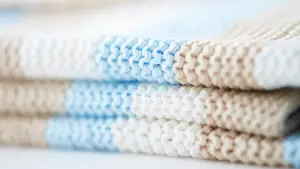
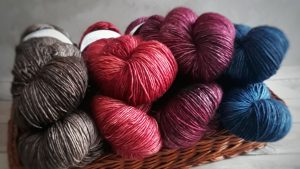
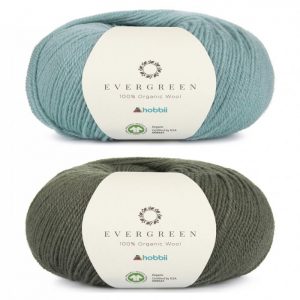
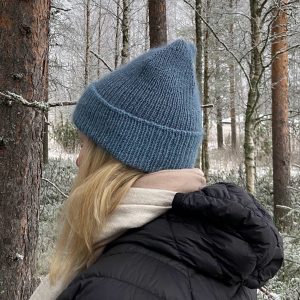
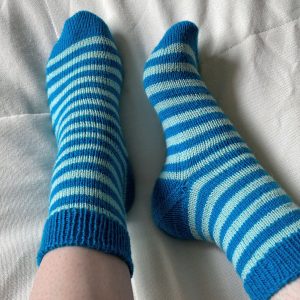
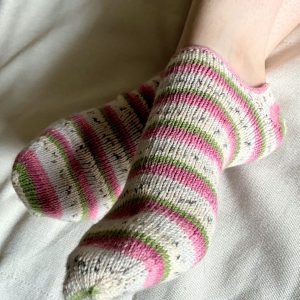
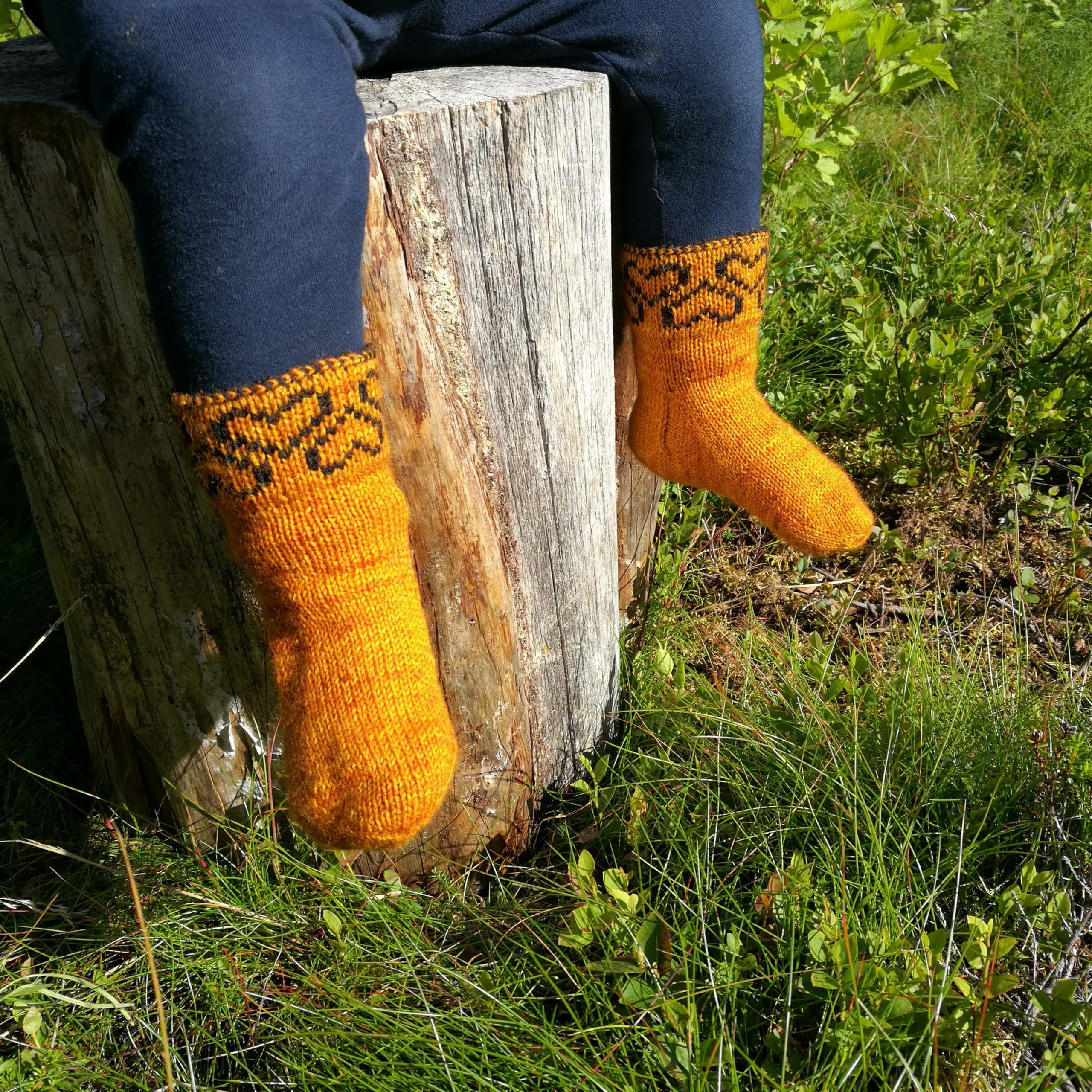

9 Responses
I use Addi sock needles with one end longer than the other. They are very comfortable and avoid any ‘ladder’ that sometimes appears with double pointed. I do use double pointed for the rib, the heel and the toe.
I chose the Chiagoo’s Full Interchangable set – and recently also bought their Lace/Socks Mini Set – which I do adore! I have no issues with any of the cables – they bend nicely and regardless of size of needles, have caused no issues. I did try the Addi needles in size 1 and 000, but found the cable tended to coil up and it happened worse as they were used more. So, that’s why I went with the Chiagoo’s Mini Set. I have all the sizes I need, and the yarn is wonderful on them. Can’t wait to start Colorwork and do a Lace Shawl with them as well – although socks are my heart 🙂
Deb
I use ChiaoGoo circular (metal)needles 40″, magic cast on, toe-up, and the same technique with Knitter’s Pride Ginger needles, 40.” Both are excellent needles. The ChiaoGoo’s metal cords bend easier, but are very difficult to use in smaller sizes with light colored yarn – my old eyes can’t see the light-colored yarn on metal and I get splits. I prefer the Gingers, but the plastic cord is stiff and non-yielding – flips up and gets in the way.
I use #1 Chaigoo Red Lace 40″ fixed circular magic loop to knit 2-at a time sox with Kroy sock yarn. I’m hoping to afford short interchangeables soon. Hoping KnitPicks will be out with a small set 0 – 3 as I own set 4 – 10 wood set interchangeabe and love them. However, Caigoo has the absolute best cables … no kinking!
I like to use Knitter’s Pride Karbonz both double point and circular. They cost more, so I try to find them on sale. They have an industrial grade carbon based shaft on the needle with a nice pointy nickel tip. I don’t have nickel allergies so it’s not a problem for me. They are smooth without being slippery, and my knitting goes faster. For socks I use bamboo double points in size 2.25mm when my Kabonz are tied up on another project. Bamboo tends to bend after a while, but it has a good grip on slippery, thin yarn. Thank you for your very informative articles.
I’ve Knitpicks needles, both metal and wooden, as well as Addi Click Rockets, but my favorites by far and my Tulip Bamboo interchangeable needles! Comfort of grip and ease of use plus the very smooth joins and the flexible cords make hours of knitting a dream!!
Can you help I want a pattern to knit sock on 2 ordinary needles not inthe round and then stitch up want a bit thicker than d.k and warmest and eat quality can you help please
I use the Knitpicks Laminated birch dpn’s for toe up socks and I have the ChiaoGoo both sets of wood and metal. I have others but these are my favorites. Have never tried the Magic loop method. Someday I might try the two socks method. I can see that way both socks come out exact. Thanks for a very good article.
I knit top down socks using 9 inch circulars. When I come to the heel I switch to DPNs and then resume with the circulars once the heel is turned. I’ve tried magic loop and using two circulars but it wasn’t enjoyable for me. I am more of a process over product knitter and for me, this way of knitting socks works but I tip my hat to those that do two at a time on magic loop.